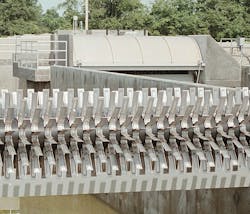Rotor Aerator Flexibility Maximizes Energy Savings
Rotor aeration has been utilized for more than 50 years to provide dissolved oxygen and mixing in more than 2,000 oxidation ditch activated sludge plants. Today’s modern horizontal rotors provide the greatest range of oxygen delivery and mixing of any mechanical surface aerator, aspirating aerator and diffused aeration systems.
The Lakeside Magna Rotor offers a typical oxygen transfer range of 3.3 to 3.6 lb oxygen per brake horsepower depending upon the rotational speed and blade immersion. The Magna Rotor operates at blade immersions from 5 to 15 in. This blade immersion range provides an average 3.25-to-1 variation in oxygen transfer. The rotational speed of the Magna Rotor can be varied from 36 to 72 revolutions per minute. The combination of rotational speed and immersion range provides an oxygen transfer range of 9.7-to-1. This flexibility allows the plant operations staff to easily match the specific oxygen uptake rate (SOUR) of the process. The flexible oxygen transfer that is provided by the Magna Rotors allows for the mixed liquor dissolved oxygen to be properly maintained during the initial start-up of the plant where the influent BOD5 and TKN loadings may be as low as 20% of the ultimate design of the plant.
Magna Rotors are offered in lengths ranging from 5 to 30 ft with two blade assembly stars per foot of torque tube length. Each blade assembly star is comprised of 12 J-shaped blades that are connected via two stainless steel bolts. The blades are formed of corrosion-resistant 10 gauge stainless steel that is die-formed. Unlike designs that utilize plastic blades or discs that become brittle in cold weather and can break, the Magna Rotor blades can take a 250 lb load without deformation or damage. The blade assembly stars are factory assembled to a finish painted 14-in. diameter torque tube with a minimum 3/8-in. thick wall.
Each Magna Rotor is provided with a field-replaceable stub shaft on each end of the torque tube. An expansion-type bearing is provided on the tail end of the torque tube and a fixed bearing on the drive end of the torque tube. A shaft-mounted speed reducer with either a standard V-belt and sheave connection to the drive motor or an optional direct drive speed reducer with a NEMA C-face motor can be provided. Maintenance is minimal with the two bearings requiring grease lubrication every two months and speed reducer oil changes three times per year.
In nearly every installation, the power consumption of the rotors is a function of the required oxygen delivery and not the power required to mix the reactor. The Magna Rotors provide mixing of the oxidation ditch to maintain a minimum 1-ft-per-second bulk liquid velocity throughout the reactor. The Magna Rotor blades operate similar to a series of canoe paddles and provide excellent mixing in reactors with liquid depths ranging from 3 to 15 ft. Deeper reactor designs are available with supplemental submersible mixers. Velocity control baffles are often provided. The velocity control baffles operate on a principle similar to the flaps on an airplane by creating more turbulent mixing that limits the maximum velocity in the reactor to less than 2 ft per second. The more turbulent mixing increases the oxygen transfer efficiency of the rotors.
For applications in cold northern climates or to minimize splash and spray on windy days, fiberglass covers are available. Each cover is provided with hinged sections that allow the cover to be opened up for access to the equipment.
Coupled with dissolved oxygen probes and variable frequency drives the Lakeside Magna Rotors provide precise dissolved oxygen control of the process. Since oxidations ditches provide nearly complete nitrification, modern day designs are set up to also take advantage of denitrification for nutrient removal, energy savings, alkalinity recovery and a better settling sludge. Nitrification and denitrification can be accomplished in the same reactor using the Magna Rotors for the aerobic nitrification phase and submersible mixers for the anoxic denitrification phase.
Rotor aerator design has been advanced over the past 50 years to provide a low-cost, flexible energy-saving oxygen delivery, mixing, and low-maintenance aerator for the oxidation ditch activated sludge process.
Contact Us
Lakeside Equipment Corp.
Bartlett, IL
630.837.5640
www.lakeside-equipment.com
[email protected]
